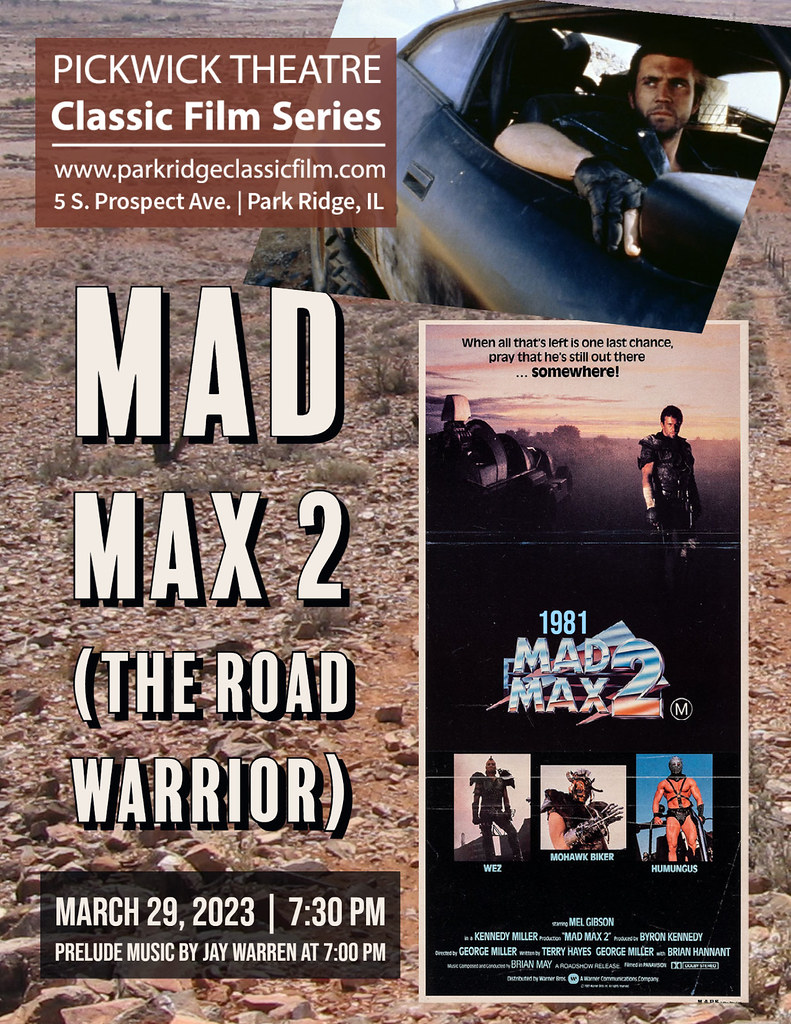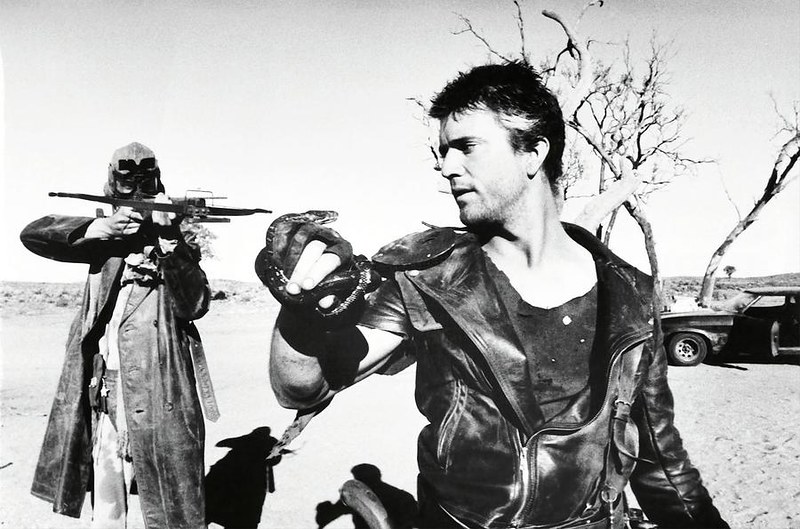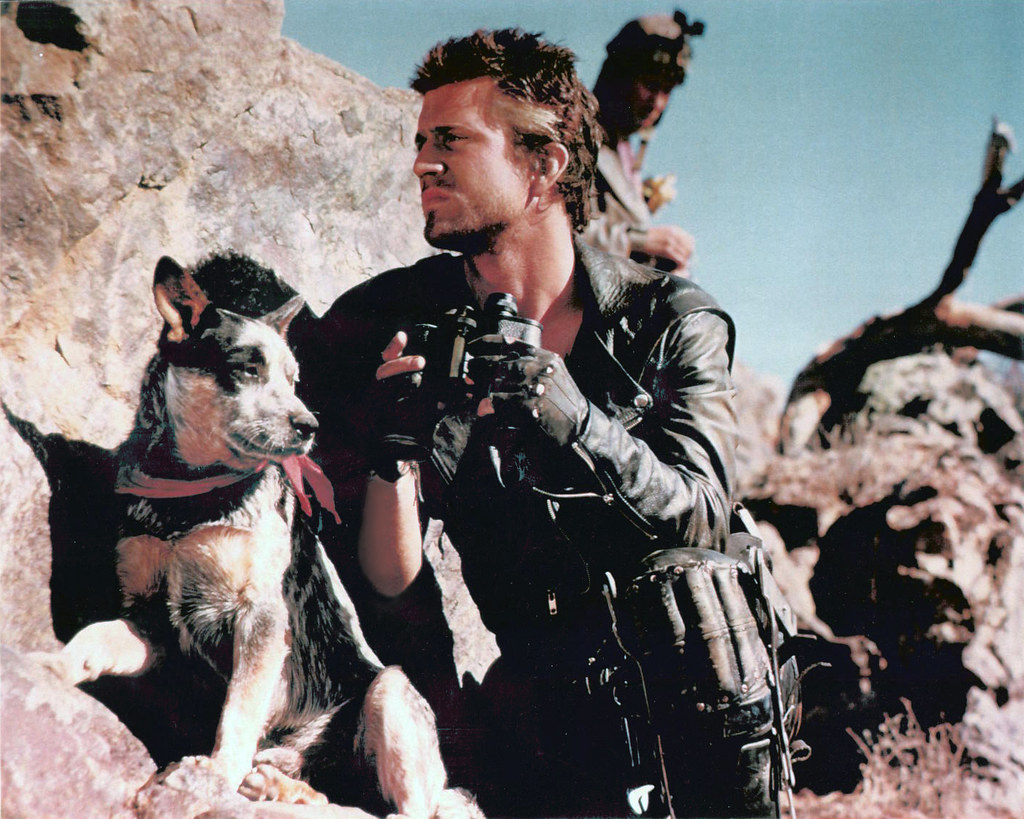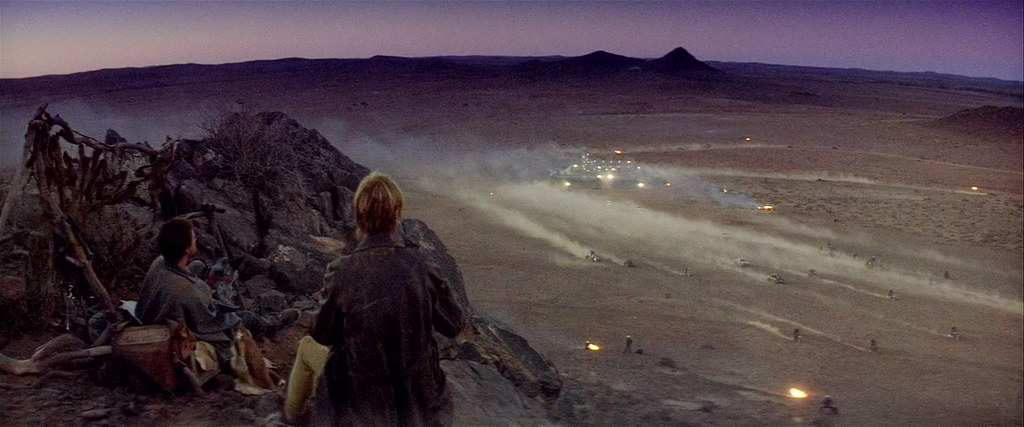WHAT: The Road Warrior aka Mad Max 2 (1981, DCP)
WHEN: March 29, 2023 1 PM & 7:30 PM
WHERE: Pickwick Theatre, Park Ridge, IL
WHAT ELSE: Pre-show music by Jay Warren at 7 PM; cartoon
HOW MUCH: $12/$10 advance or $10 for the 1 PM matinee
Advance Tickets: Click Here!
NOTE: This film is Rated R.
“Above all, two things excited us about [Joseph] Campbell’s insights. First, we weren’t just filmmakers. We realized that we were 20th-century storytellers, and while the technology at our disposal was more sophisticated than in any other age, the aim was still the same: to weave stories which would satisfy those longings within other people and at the same time confirm certain values that we all hold dear. Second, we were convinced that in the character of Max– almost by accident– we had the makings of a real hero, yet another one of Campbell’s 1,000 faces.” ~Director George Miller
The last of our “Mega-screen” presentations is March 29, 2023, and we’ll be going out with a bang…
Over forty years after its release, The Road Warrior (1981) remains an outstanding achievement in the action film genre. It raised the standard for post-apocalyptic cinema. Directed by visionary filmmaker George Miller, The Road Warrior weaved some of the most astonishing stunts ever filmed into a narrative that plays as a modern myth. Its climactic finale, involving a tanker on a highway, remains one of the greatest chases ever filmed. But what separates the film from so many others is that the action and stunts never overshadow the performances. The film is filled with memorable characters but is anchored by the iconic performance of Mel Gibson.
The Road Warrior will be presented on March 29, 2023, at the historic Pickwick Theatre. This will be the swan song for the Mega-Theatre, which went up during the renovation of 2018. Over the course of five years, we’ve been able to project dozens of spectacular films that took full advantage of the larger canvas. Knowing that the end was coming in 2023, we felt The Road Warrior would be a terrific choice to wrap things up. The cinematography– those vast Australian landscapes– would lend itself well to the big screen.
The Road Warrior (or Mad Max 2, its official title in Australia) is a follow-up to George Miller’s 1979 film, Mad Max. Made on a low budget, the original was a tale of vengeance about a cop whose family is killed by a motorcycle gang. It was a huge hit in Australia. In the United States, however, Mad Max had limited distribution. In addition, the actors, including American-born Mel Gibson, were re-dubbed for the American release. Despite these challenges, the film eventually found its audience. Mad Max became a cult film, turning Mel Gibson into an international star.
The Road Warrior was produced by Byron Kennedy and written by Terry Hayes, George Miller, and Brian Hannant. It took roughly a year from the time they started on a screenplay (around Christmas 1980) to the time it was released in theatres (Christmas 1981). That in itself is a major accomplishment considering most movies are in development for years. Miller, however, had a lot of pent-up energy after the limitations from the first film. Instead of directing a movie like First Blood, which he was offered in the aftermath, Miller turned his attention to doing a Mad Max sequel.
The writers tapped into mythology and the hero’s journey. Like George Lucas before them, they were heavily influenced by the writings of Joseph Campbell. Campbell’s work on the “power of myth” helped Miller form a character that would be universal, almost larger than life. This gave the film its structure. The dialogue would be done in a minimalist fashion. In fact, save for the opening narration– which establishes the hero legend– the first sequence in the film is all done without any spoken lines. Mel Gibson only has sixteen lines of dialogue in the entire film. Instead, George Miller opted to tell his story using film language.
Mel Gibson is Max, a burned-out “shell of a man” in search of a tank of gas (and not much more). All he has left in the world is his dog and his V-8 Interceptor. Out in the wasteland, he finds a fuel-pumping derrick run by a group of harassed settlers. They’re in need of a hero as their compound is attacked daily by a band of marauders. The gang is led by “The Humungus,” who is determined to gain access to their gasoline. The settlers, under the leadership of Pappagallo, have a plan to escape. But only Max, now a champion of the oppressed, can open up the road to the “sunshine coast.”
Budgeted at $4.5 million, The Road Warrior was shot in Broken Hill, New South Wales. Production lasted twelve weeks. The film features many stunning locations set against the Australian outback. Perhaps none are as picturesque as the scenes set on Max’s mountain look-out with the refinery below. The film was shot in continuity with Miller taking a more gonzo approach to shooting: it was a film made on adrenaline and instinct. The crew basically did what they had to in the moment. When they were constrained by time (or simply the time of day), they just had to roll. Sometimes shots were improvised on the spot. It was a style that went back to the tricks of low-budget filmmaking. Several shots, for instance, were hand-held (in the days before there was a steady cam). As a result, The Road Warrior has a raw energy that could never be duplicated today.
During the shoot, the actors met to discuss their roles. It was a period of “immersion” in which they got a feel for their characters. The cast came from all over; the actors had experience in theatre, film, television, even commercials. The star, Mel Gibson, had already established himself with Mad Max. In the sequel, he reprised his character of Max Rockatansky– a cop turned scavenger. His Max is a reluctant hero who comes back to the fold of humanity. Gibson’s acting career has had its share of ups and downs over the decades with an off-screen life that can be called, at best, a paradox, but he was never better or more charismatic than in this film. Mad Max was his best version of himself as an actor. He’s subdued and devoid of that manic energy so common in the later Mel performances.
The rest of the cast includes the wonderful Bruce Spence as the eccentric, snake-eating Gyro Captain, Mike Preston as the dignified Pappagallo, Vernon Wells as the mohawked Wez, Emil Minty as the boomerang-throwing Feral Kid, and Kjell Nilsson (a former Swedish weight lifter) as the hockey mask-wearing Lord Humungus (“The Ayatollah of Rock-and-Rollah.”)
The dog in the film, a Blue Heeler breed (or Australian Cattle Dog), was discovered in a pound by one of the crew. In fact, the dog was on “death row” and scheduled to be euthanized the following day. It was apparent, however, that the dog was quite intelligent and could be trained to do tricks. Not only did he become a movie star in this film, but he lived to enjoy his retirement on a farm. (He was adopted by one of the camera operators.)
The visual design of a George Miller film always reflects a high degree of originality and imagination. The look of The Road Warrior is like a world that has fallen apart and somehow has been put back together with whatever was handy. (The wardrobe, in fact, came from various sporting outlets and S&M leather stores!) One of the most memorable elements of this universe is Max’s car, which is like another character. The black Interceptor, first seen in Mad Max, is one of the most recognizable cars in film history. The entire film, in fact, is nirvana for car enthusiasts.
The Road Warrior offers some stunning lighting techniques. Particularly impressive are the scenes at dusk– those shot at the “magic hour,” as the film crew referred to it– when the filmmakers had a very small window to get the shots in. One of the most gorgeous shots lasts for only a few seconds: the pre-dawn light bathing Max in his car as he tries to outrace his pursuers after leaving the compound. From the opening shot of the movie onward, it’s just extraordinary work from cameraman Dean Semler. (Semler would later win an Academy Award for Best Cinematography for Dancing With Wolves.)
The Road Warrior is a high watermark in the history of movie stunts. It’s remarkable to think that the stunts were all accomplished by just a handful of fearless stuntmen on the set. This was in the days before computer effects and green screens did all the work. As a result, it feels more real; those are real cars flipping over. At one point, a biker hits a stationary dune buggy and cartwheels 65 feet through the air! The crew had to coordinate the movements and stunts for 80 custom vehicles. The highlight, undoubtedly, is the 13-minute tanker chase, which is actually two minutes longer than John Ford’s famous Indian chase in Stagecoach (1939). The Road Warrior even rivals the truck chase in Raiders of the Lost Ark for pure excitement, which was also released in 1981.
The music was performed by the Australian composer Brian May, who had also done the first film. His score is haunting, establishing a melancholy for the fate of mankind. It’s very much evocative of its setting in the post-nuclear outback. Additionally, the music captures the rhythms of George Miller’s editing. May’s themes are so much a part of the film that it’s hard to imagine it without them. The music carries the audience along through the action, but it also makes people feel something deeper. The two Mad Max films represent Brian May’s best work as a composer.
The Road Warrior is a very visceral film, but unlike today’s movies that have a tendency to desensitize audiences with cartoon violence, there is human emotion behind what is shown. When a story like this can take a moment to reflect on the death of an individual– for instance, the brutality witnessed by the Gyro Captain– you know the film is operating on another level. The humanity in its quieter moments is what makes the film resonant.
The Road Warrior certainly resonated with me in the summer of 1982 when I saw it with my dad at the Golf Mill Theatre in Niles, IL. I was three years younger than “The Feral Kid.” The early 1980s were a happy time for a kid; it was the era of Indiana Jones, Star Wars, and Superman, and so many others. At that time, like most American audiences, I had no idea I was even watching a sequel. (In fact, many adults didn’t know there was a Mad Max either. Renaming the sequel The Road Warrior was Warner Bros’ way to distance it from a film that most Americans had not seen.)
The Road Warrior was one of those special movie experiences that can only be born in a theatre. You remember specific moments more vividly, as when Max sends the Feral Kid out across the hood to grab the last remaining bullet. “Get the shell!” he tells him. My heart seemed to race as fast as his in that moment, and that is the magic of the movies. Mel Gibson, in his finest hour, made an impression on me the way Alan Ladd had impressed my dad in Shane (1953). The Road Warrior neatly fits into the classic Western archetype while drawing audiences into a new movie mythology.
Mel Gibson would return to the role one final time in the ambitious and somewhat underrated Mad Max Beyond Thunderdome in 1985. Though it was a far cry from its predecessor in terms of impact, Thunderdome, to its credit, wasn’t a retread. It was certainly different enough with a Lord of the Flies-style storyline. It was more philosophical than what had come before. The film did feature an exciting climax and a denouement that maintained the mythos of the Mad Max character.
The Road Warrior is one of the best films of the 1980s– or any decade, for that matter– and one of the finest sequels ever made. It was an immediate critical and box office success when it was released December 24, 1981. (It hit American theatres the following summer.) All these years later, it remains just as thrilling for moviegoers. The Pickwick Theatre Classic Film Series is excited to be presenting this film as our final Mega-screen presentation. Join us as we ride Hell’s highways with this rare theatrical screening. Don’t let it pass you by.
~MCH






